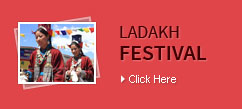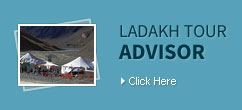
ANCIENT BUDDHIST MONASTERIES (Gompa) OF LADAKH
These ancient Buddhist monasteries in Ladakh are the main source of attraction for the tourists as they truly represent the age old religion and culture of Ladakh. The monasteries are repositories of exquisite murals, gilded statues, religious icons, carvings, scrolls etc. built up through the ages. They remain alive with the devotions of monks, young and old. The monasteries of Ladakh are situated in scenic locations, on hills and mountains. The locals are in one way or the other associated with their respective monasteries.
Some precautions to be observed while visiting a monastery:
- Visitors are required to take off their shoes before entering a prayer area.
- Observe local dress codes, such as wearing clothing that covers your limbs.
- Do not disturb Monks at prayer, and always ask permission before taking photographs.
- Do not touch religious artifacts.
- Do not drink, smoke, take drugs or spit in the monastery premises
- Avoid talking loudly or disturbing the peaceful atmosphere
- Most Monasteries charge an admission fee of about Rs. 25 to 50. If a fee is not charged, it is considered appropriate to leave a donation for the maintenance of the monastery.
- In many Monasteries, you are expected to walk around the premises only in a clockwise direction.
- Women may not be allowed to enter the inner prayer rooms of some monasteries.
Namgyal Tsemo Gompa
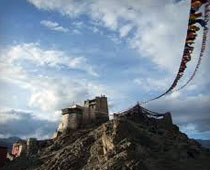 Namgyal Tsemo Gompa was founded in the early 15th century, around the year 1430. It stands atop the crag behind Leh palace, having a full view of the town of Leh. And because of this position, it offers some of the most splendid visuals of the town. The Namgyal Tsemo Gompa was founded by King Tashi Namgyal and therefore has been named after him. It boasts of a rich collection of some ancient manuscripts and wall paintings.
Namgyal Tsemo Gompa was founded in the early 15th century, around the year 1430. It stands atop the crag behind Leh palace, having a full view of the town of Leh. And because of this position, it offers some of the most splendid visuals of the town. The Namgyal Tsemo Gompa was founded by King Tashi Namgyal and therefore has been named after him. It boasts of a rich collection of some ancient manuscripts and wall paintings.
One of the most treasured possessions of the monastery is a three-storey high solid gold idol of Maitrieya Buddha (future Buddha). The monastery also houses a statue of Avaloketesvara and Manjushri, approximately one storey high.
SANKAR GOMPA
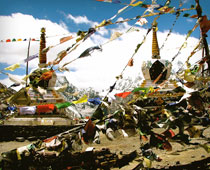 Located in Samkar village of Leh, Samkar Gompa is the summer residence of the Abbot of Spituk monastery, the Venerable Kushok Bakula, who is the senior incarnate lama of Ladakh due to his ancient lineage and personal authority. Only 20 monks most resides here, so visiting hours are limited to early morning and evening. The place is well lit, so an evening visit is worthwhile. Climbing the steps one reaches the double doors leading into the dukang or assembly hall. The wall and entry door are richly painted. Upstairs is the Dukar Lhakang ("residence of the deity") or inner sanctuary. There is an impressive figure here of female Bodhisattva Sitatapatra with 1,000 arms (all holding weapons) and 1,000 heads especial and unique feature. The walls are painted with a tantric deities, Mandalas and rules for the monks. Above the wooden stairs can be seen the rooms of the Abbot, guest rooms and the library.
Located in Samkar village of Leh, Samkar Gompa is the summer residence of the Abbot of Spituk monastery, the Venerable Kushok Bakula, who is the senior incarnate lama of Ladakh due to his ancient lineage and personal authority. Only 20 monks most resides here, so visiting hours are limited to early morning and evening. The place is well lit, so an evening visit is worthwhile. Climbing the steps one reaches the double doors leading into the dukang or assembly hall. The wall and entry door are richly painted. Upstairs is the Dukar Lhakang ("residence of the deity") or inner sanctuary. There is an impressive figure here of female Bodhisattva Sitatapatra with 1,000 arms (all holding weapons) and 1,000 heads especial and unique feature. The walls are painted with a tantric deities, Mandalas and rules for the monks. Above the wooden stairs can be seen the rooms of the Abbot, guest rooms and the library.
Thiksey Gompa
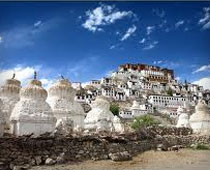 Built in the 15th century, the Thiksey Gompa is situated nearly 20 kms away from the Leh city and is the most beautiful and well maintained monasteries of Ladakh. It belongs to the Gelugpa order. The structure of this monasteries strikingly resembles the Potala of Tibet. It contains 10 temples, below the monastery itself is chapels and houses of monks stretching down the hillside. Around 100 monks affiliated to yellow-hat sect of Buddhism resides in this monastery. A large Maitreya (future Buddha) statue 15 meters in heights is the most attractive part of this monastery. This statue is the largest Buddha figure in Ladakh
Built in the 15th century, the Thiksey Gompa is situated nearly 20 kms away from the Leh city and is the most beautiful and well maintained monasteries of Ladakh. It belongs to the Gelugpa order. The structure of this monasteries strikingly resembles the Potala of Tibet. It contains 10 temples, below the monastery itself is chapels and houses of monks stretching down the hillside. Around 100 monks affiliated to yellow-hat sect of Buddhism resides in this monastery. A large Maitreya (future Buddha) statue 15 meters in heights is the most attractive part of this monastery. This statue is the largest Buddha figure in Ladakh
STAKNA GOMPA
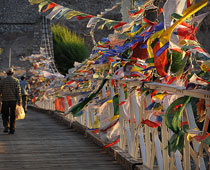 Located in beautiful Stakna village of Indus valley, this Gompa was founded in the late 16th century by a Bhutanese scholar and saint, Chosje Jamyang Palkar. The name, literally meaning 'tiger's nose' was given because it was built on a hill shaped like a tiger's nose. Of note is a sacred Arya Avalokiteshvara statue from Kamrup, Assam. Stakna has a residence of approximately 30 monks and belongs to the Drugpa Kargyu monastic order of Tibetan Buddhism.
Located in beautiful Stakna village of Indus valley, this Gompa was founded in the late 16th century by a Bhutanese scholar and saint, Chosje Jamyang Palkar. The name, literally meaning 'tiger's nose' was given because it was built on a hill shaped like a tiger's nose. Of note is a sacred Arya Avalokiteshvara statue from Kamrup, Assam. Stakna has a residence of approximately 30 monks and belongs to the Drugpa Kargyu monastic order of Tibetan Buddhism.
CHEMREY MONASTERY
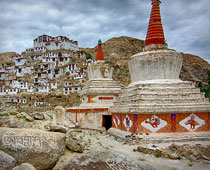 Located in Chemrey village to the east of Leh, this Gompa belonging to the Drukpa Kargyud monastic order was founded in 1664 by the Lama Tagsang Raschen. The monastery has a notable high Padmasambhava statue. It also contains a valuable collection of scriptures, with title pages in silver and the text ingold letters. The monastery is also a venue for the festival of sacred dances which takes place on the 28th and 29th day of the 9th month of theTibetan calendar every year.
Located in Chemrey village to the east of Leh, this Gompa belonging to the Drukpa Kargyud monastic order was founded in 1664 by the Lama Tagsang Raschen. The monastery has a notable high Padmasambhava statue. It also contains a valuable collection of scriptures, with title pages in silver and the text ingold letters. The monastery is also a venue for the festival of sacred dances which takes place on the 28th and 29th day of the 9th month of theTibetan calendar every year.
Hemis Gompa
Hemis monastery is the largest and richest of all monasteries in Ladakh. Situated 45 kms south of Leh, the monastery was founded by Lama Stagtsang Raspa under the direct patronage of King Singey Namgyal in the year 1630. The Gompa contains large number of images, thangkas, mandalas, historical and ritual objects and religious scriptures. A large number of historical and ritual objects have been displayed in a well maintained museum at Hemis.
Lamayuru Gompa
The Lamayuru Gompa si remarkably built on natural pillar like formations of sandstone. It lies around 125 kms west of Leh. The monastery belongs to the Drigunpa order of Tibetan Buddhism.
The history of the monastery begins with the visit of Arahat Nimagung to this place, when there was merely a lake here. It is said that Arahat made a prophecy that the monastery will come up at this spot and be made offerings (prayer with grains of corn) to the Nagaserpent spirits. The corns mixed with the earth and grew in the form of Swastika (Yundrung) and that was how the monastery got its name Yungtrung Tharpaling Monastery.
The Great translator Rinchen Zangpo contructed a temple here in the eleventh century. Naropa also visited Lamayuru which was taken care of by Kadampa school of Tibetan Buddhism. But later it was taken over by Digungpa order. This monastery also has a festival called ‘Yuru Kabgyat’, which takes place on 17th and 18th of the 5th month of Tibetan calendar.
KORZOK GOMPA
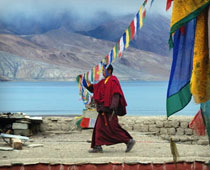 Located in Changthang nomadic highland, Korzok Gompa is situated on the western bank of a beautiful Tsomoriri Lake. Founded in 17th century it houses a Shakyamumi Buddha and other statues. It is home to about 35 monks, belongs to the Drukpa Kargyud monastic order and falls under the jurisdiction of the Hemis monastery. In the past, the monastery was the headquarters of the Rupshu Valley. The old monastery was built on a gentle slope, unlike other monasteries that are generally perched on hill tops. Monastery as seen now is said to have been re-built in the 19th century. A number of Chortens are also seen near the monastery.
Located in Changthang nomadic highland, Korzok Gompa is situated on the western bank of a beautiful Tsomoriri Lake. Founded in 17th century it houses a Shakyamumi Buddha and other statues. It is home to about 35 monks, belongs to the Drukpa Kargyud monastic order and falls under the jurisdiction of the Hemis monastery. In the past, the monastery was the headquarters of the Rupshu Valley. The old monastery was built on a gentle slope, unlike other monasteries that are generally perched on hill tops. Monastery as seen now is said to have been re-built in the 19th century. A number of Chortens are also seen near the monastery.
The Tsomoriri Lake in front of it is also held in reverence, and considered equally sacred by the local people. The Korzok Gu-stor festival is held at the monastery and attracts many Chang-pas, the Tibetan nomadic herdsmen. The festival lasts for two days (July/August) and ends with the dismemberment and dispersal of the 'Storma' (sacrificial cake) by the leader of the Black dancers in a ceremony called 'Argham' (Killing).
Deskit Gompa
Deskit Gompa is located at a picturesque sight perched on a hill. It was founded by Lama Sherab Zangpo of Stod in 1420 AD during the reign of King Dragspa. About 100 monks are residing in the Gompa. It is a branch of Thiksey Monastery. The monastic festival called Gustor takes place on the 20th and 21st days of the 12th month of the Tibetan calendar. The monastery overlooks the fantastic landscape of the Nubra valley.
Alchi Gompa
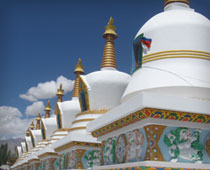 Renowned as the oldest Buddhist learning centre in Ladakh, Alchi Monastery is located 70 km from Leh in Jammu and Kashmir in north India on the bank of Indus River. A national heritage, it is distinct from other monasteries in Ladakh as it is situated on flat ground unlike others which are located on hilltops.
Renowned as the oldest Buddhist learning centre in Ladakh, Alchi Monastery is located 70 km from Leh in Jammu and Kashmir in north India on the bank of Indus River. A national heritage, it is distinct from other monasteries in Ladakh as it is situated on flat ground unlike others which are located on hilltops.
The foundation of the monastery was laid by Tibetan translator Rinchen Zangpo in the middle of 12th century. It has three main structures known as Du-khang, Sum-tsek and the temple of Manjushri. Du-khang, the assembly hall, is the largest and the oldest preserved part of the monastery. Walls of the assembly hall are full of ancient paintings that depict different forms of Buddha and goddesses. Sum-tsek, the three-story temple is popular for its four armed big Bodhisattva statue which occupies two floor of the temple. On the ground floor there is a Maitreya Buddha along with figure of white Avalokiteshvara and Manjushri. Temple of Manjushri is also known as Jampe Lhakhang. Along with images of Manjushri, the temple has sculpture and a painting of Rinchen Tsangpo.
Liker Gompa
The Likir Gompa stands 62 km west of Leh. It was during the rule of the fifth king of Ladakh, Lhachen Gyalpo, that land was offered to Lama Duwang Chosje, an eminent advocate of meditation, to construct the monastery. The lama graced the land and the monastery came up in 1065 AD.
The monastery was enclosed by the bodies of the two great serpent spirits or the naga- rajas, Nanda and Taksako. Because of this, the name of the monastery became Likir or the Naga encircled. Initially, the monastery was associated with the Kadampa sect, however, the year 1470 saw a conversion by a central Tibetan monk Lawang Lotos. This conversion resulted in the monastery being brought under the Gelugpa Order. Clay Images of three Buddhas - "Marme Zat" (past), "Sakyamuni" (present) and "Maitreya" (Future) - dominate the Du-khang whereas the Gon-khang houses a statue of "Tse-Ta-Pa", the wrathful protector. Additionally, the impressive murals of "Yamantaka" and "Mahakala" too adorn the Gon-khang. The monastery is also a repository of various old manuscripts, attractive collection of thankas, old religious and domestic costumes and implements. A huge Jupiter tree, amongst the few remaining ones of its species stands majestically in the courtyard. Nearly 100 monks resides in this monastery.
Spituk Gompa
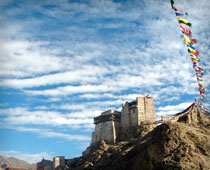 This monastery dates back to the 11th century. It owes its inception to Od-de, the elder brother of Lha Lama Changchub Od. Od-de led to the establishment of a monastic community at this place. Spituk is a three-chapel monastery. The name "Spituk", meaning exemplary, has been derived from a statement of a translator, Rinchen Zangpo, about the monastery. He said that an exemplary religious community would develop there, providing the name Spituk for the monastery.
This monastery dates back to the 11th century. It owes its inception to Od-de, the elder brother of Lha Lama Changchub Od. Od-de led to the establishment of a monastic community at this place. Spituk is a three-chapel monastery. The name "Spituk", meaning exemplary, has been derived from a statement of a translator, Rinchen Zangpo, about the monastery. He said that an exemplary religious community would develop there, providing the name Spituk for the monastery.
At that point of time, the Spituk Monastery was under the Kadampa School. Slowly and gradually, as time passed, the monastery started functioning under Dharmaraja Takspa Bum - Lde Lama Lhawang Lotus. He brought about the restoration of Spituk and introduced the stainless order of Tsongkhapa (Gelukpa). Even today, the monastery functions under the Gelukpa order only. Three other monasteries of Ladakh, namely Stok, Sankar and Saboo, are considered to be the branches of Spituk Gompa.
The incumbents serving in all these monasteries are the successive reincarnations of Skyabsje Bakula Rinpoche. The main image inside the Spituk Monastery is that of Lord Buddha. Along with that is a sacred image of Amitayus, about a finger high in length. Tsongkhapa, himself, presented this image, to Takspa Bum-Lde. It also boasts of a rich collection of thangkas, ancient masks, antique arms, etc. And not to be missed is an impressive image of Mahakaal.
The Dukhang (main temple) also has a high throne at its far end, reserved for the Dalai Lama. The door beside this central throne leads to dark old chapel. The central images inside the chapel are those of Tsong-kha-pa, his two chief disciples and of the Buddha. Spituk Gompa also plays the host to the Gustor Festival, held every year. The festival takes place from the 27th to 29th day in the eleventh month of the Tibetan calendar. A sacred dance also forms a part of the celebrations.
Shey palace and Gompa
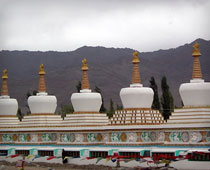 Shey which means looking glass got its name due to the reflection of the Palace in the small lake situated below the palace. Today it stands proudly approximately 15 kms from Leh town on the bank of river Indus. Shey has the credit for being the first for constructed by the first kind of Ladakh Lhachen Spalgigon and the fort ruins can be seen even today right above the present Shey Palace.
Shey which means looking glass got its name due to the reflection of the Palace in the small lake situated below the palace. Today it stands proudly approximately 15 kms from Leh town on the bank of river Indus. Shey has the credit for being the first for constructed by the first kind of Ladakh Lhachen Spalgigon and the fort ruins can be seen even today right above the present Shey Palace.
The main image in the monastery is a three storeyed statue of Buddha Shakyamuni, made of copper guilt, which was made by Deldan Namgyal in the memory of his father Singay Namgyal. The statue is the only of its kind in the region. Some exquisite murals adorn the second storey of the Shey Monastery, while the lower storey comprises of a large library and is decorated with murals depicting Buddha, with various types of hand gestures. An annual festival is also held at Shey Gompa, on the 30th day of the first month of the Tibetan calendar.
Matho Gompa
Matho Gompa is situated at a distance of 26 kms south east of Leh on the left side of Indus river. It was founded by Lama Dungpa Dorje in the first half of sixteenth century. The Gompa is the only representative of Sakya sect in Ladakh. The Gompa contains a large number of images including Sakya Pandit Kunga Gyaltsan, other Saskya Lamas and thangkas etc. Many of the thangkas are said to be brought from Tibet. Matho Gompa is famous for its annual festival ‘Matho Nagrang’ of the oracle named Rongtsan Kar-mar usually held in March. The oracles are two Lamas, chose by lot every three years who, when purified by months of fasting and meditation, become the receptacles for the spirit of the deities.
Phyang Gompa
Phyang monastery , 17 kms west of Leh is built on a hilltop. This monastery belongs to the Dregungpa order of Tibetan Buddhism. It was the first monastery to introduce Dregungpa teaching of Skyoba, Jikstan Gonbo in Ladakh. The gonbo was founded by Chosjey Dhamma Kunga, during the reign of king Jamyang Namgyal in the 16th century A.D. It has about 50 monks residing. The two-day Phyang Tseruk (monastic festival) falls on the 2nd and 3rd of the 6th month of Tibetan calendar.
Takthok Gompa
The name Takthok, literally meaning 'rock-roof' was named because both, its roof as well as walls is made up of rock. The site where the monastery is now situated, once served as the meditation cave of Mahasidhas "Kunga Phuntsog". It belongs to the Nyingma sect of Tibetan Buddhism and approximately 55 lamas reside there. It is the only Nyingma monastery in Ladakh.
The monastery was founded around the mid-16th century during the reign of Tshewang Namgyal on a mountainside around a cave in which Padmasambhava is said to have meditated in the 8th century. Every year on the 9th and 10th day of the sixth month of the Tibetan calendar, celebrations of the festival include sacred dances and the ceremony of hurling a votive offering.
To the left of the central courtyard is the cave chapel of the monastery. Opposite the chapel are the images of Padme Sambhava and Avalokitesvara. There is a small cave behind these images, believed to be the place where Padmasambhava lived and meditated for three years. On the right of the central courtyard, lies the Dukhang or the main assembly hall. Murals of guardian divinities adorn the verandah entrance to the Dukhang. But, they are displayed only at the time of the annual festival of the monastery. There is a throne inside the Dukhang, reserved solely for the Dalai Lama. It is situated just opposite to the Dukhang entrance. The wall to the left of the throne stands decorated with the mural of Padmasambhava, while the one on the right has a painting of Sakyamuni.
Also inside the Dukhang, are the statues of Maitreya (the Future Buddha or Buddha of Compassion), Padmasambhava and Dorje Takposal (a manifestation of Padmasambhava).
Rizdong Gompa
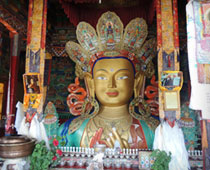 The Rizdong Gompa situated at the top of a rocky side valley was founded by the great Lama Tsultim Nima in the year 1831. It belongs to the Gelukpa Order. The monastery serves as the residence of approximately 40 monks. Rizdong Gompa is noted for its extremely strict rules and standards. The inmates of the monastery are not permitted to have anything on their person, except for religious robes and books. The Monastery consists of a number of shrines inside its complex.
The Rizdong Gompa situated at the top of a rocky side valley was founded by the great Lama Tsultim Nima in the year 1831. It belongs to the Gelukpa Order. The monastery serves as the residence of approximately 40 monks. Rizdong Gompa is noted for its extremely strict rules and standards. The inmates of the monastery are not permitted to have anything on their person, except for religious robes and books. The Monastery consists of a number of shrines inside its complex.
The gompa also has quite a rich collection of the painting blocks of Lama Tsultim Nima's biography as well as a number of objects made and books composed by the first Sras Rinpoche. Serving as the incumbents of the Rizdong Monastery, are the successive reincarnations of Lama Tsultim Nima and his son, Sras Rinpoche. A nunnery, known as Chulichan (Chomoling) is located near the monastery, at a distance of approximately 2 km.
Comprising of about 20 nuns, the nunnery is under the control of the governing body of Rizdong Monastery only. The nun, known as Chomos, worship at the temples of the monastery itself.
Rangdum Gompa
Rangdum Monastery is an 18th century monastery belonging to the Gelugpa sect, situated on top of a small but steep sugarloaf hill at an altitude of 11,998 ft (3,657 m) at Zangskar valley. The monastery rises over a centrally ascending mound, entrenched around by the bifurcated route of a mountain stream. The Rangdum Gompa of Ladakh gives the appearance of an age-old fortification, which is standing as the protector of a mystical mountain valley. It is next to the tiny village of Julidok, and about 25 km from the 14,436 ft (4,400 m) Pensi La (pass) which leads into Zanskar.
Phugtal Gompa
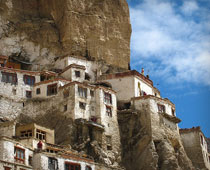 One of the most isolated monasteries of the region, the Phugtal Gompa dates back to the early 12th century. Situated in the Zanskar region, the Phugtal Monastery (often transliterated as Phuktal) stands at the opening of a huge cave. Founded by Gangsem Sherap Sampo, the monastery is a unique construction built into the cliffside like a honeycomb. It is located on the mouth of a cave on the cliff face of a lateral gorge of a major tributary of the Lungnak (Lingti-Tsarap) River. To reach the Phugtal Monastery, one can also go through the Padum-Manali trekking route.
One of the most isolated monasteries of the region, the Phugtal Gompa dates back to the early 12th century. Situated in the Zanskar region, the Phugtal Monastery (often transliterated as Phuktal) stands at the opening of a huge cave. Founded by Gangsem Sherap Sampo, the monastery is a unique construction built into the cliffside like a honeycomb. It is located on the mouth of a cave on the cliff face of a lateral gorge of a major tributary of the Lungnak (Lingti-Tsarap) River. To reach the Phugtal Monastery, one can also go through the Padum-Manali trekking route.
A number of chapels are situated inside the premises of the Phugtal Gompa. And one of these chapels even reflects a strong Indian touch. The frescoes as well as the ceiling decorations, adorning the chapel, bear the marks of artistic and iconographic influence of India. Also, the monastery serves as the residence for approximately 40 monks.
WANLA GOMPA
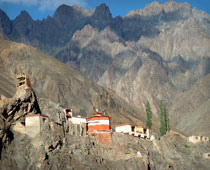 Located in Sham valley, Wanla Gompa is a sub-monastery of Lamayuru which provides a caretaker monk responsible for daily rituals and for granting access to the temple. .It has small but impressively preserved three-storeyed Avalokitesvara temple, one of the earliest known Drigung Kagyu prayer chambers to have survived in Ladakh. The main image features Avalokitesvara in 11-headed ("Chukshigzhal") form.
Located in Sham valley, Wanla Gompa is a sub-monastery of Lamayuru which provides a caretaker monk responsible for daily rituals and for granting access to the temple. .It has small but impressively preserved three-storeyed Avalokitesvara temple, one of the earliest known Drigung Kagyu prayer chambers to have survived in Ladakh. The main image features Avalokitesvara in 11-headed ("Chukshigzhal") form.
SUMDA CHOON GOMPA
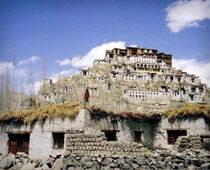 Located in Sham valley, this Gompa is situated in Sumda village, which is around 65 kms south-west of Leh. The Sumda Choon monastery was founded by Lotsava Rinchen Zangpo in 11th century. It is said that he built three temples including Sumda, Alchi and Mangyu monastery simultaneously. The principle image of Sumda Choon Gompa is the four headed Varocana, which is the control figure of the five Dhyani Buddhas. The beauty and splendor of this image surpasses those of similar images at Alchi and Mangyu Gompa. The mural comprises the images of five Dhyani Buddhas including Ratnasambhava, Akshobhya, Amitaba, Amogasiddhi and Varocana.
Located in Sham valley, this Gompa is situated in Sumda village, which is around 65 kms south-west of Leh. The Sumda Choon monastery was founded by Lotsava Rinchen Zangpo in 11th century. It is said that he built three temples including Sumda, Alchi and Mangyu monastery simultaneously. The principle image of Sumda Choon Gompa is the four headed Varocana, which is the control figure of the five Dhyani Buddhas. The beauty and splendor of this image surpasses those of similar images at Alchi and Mangyu Gompa. The mural comprises the images of five Dhyani Buddhas including Ratnasambhava, Akshobhya, Amitaba, Amogasiddhi and Varocana.
LINGSHED MONASTERY
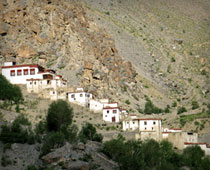 Lingshed Village, at the heart of the Trans-Sengge-La region between Ladakh and Zanskar, has been inhabited for nearly a thousand years. The village has been the site of several Buddhist monasteries: the remnants of a cave monastery and two walls dedicated to the translator Rinchen Zangpo (958-1055). Lingshed Monastery was founded as a Gelukpa School Monastery in the 1440s by Changsems Sherab Zangpo, disciple of Je Tsongkhapa. In 1779, the Ladakhi king Tsewang Namgyal donated the lands of Lingshed village and its surrounding villages to Lama Lobsang Gelek Yeshe Dragpa, the 3rd incarnation of the Ngari Rinpoche lineage. The monastery houses about 60 monks. It serves the surrounding villages of Lingshed, Skyumpata, Yulchung, Nyeraks, Dibling and Gongma villages. The monastery consists of six principal shrines, kitchens, and store rooms and - on its uppermost floor - an apartment for Ngari Rinpoche or other visiting high lamas.
Lingshed Village, at the heart of the Trans-Sengge-La region between Ladakh and Zanskar, has been inhabited for nearly a thousand years. The village has been the site of several Buddhist monasteries: the remnants of a cave monastery and two walls dedicated to the translator Rinchen Zangpo (958-1055). Lingshed Monastery was founded as a Gelukpa School Monastery in the 1440s by Changsems Sherab Zangpo, disciple of Je Tsongkhapa. In 1779, the Ladakhi king Tsewang Namgyal donated the lands of Lingshed village and its surrounding villages to Lama Lobsang Gelek Yeshe Dragpa, the 3rd incarnation of the Ngari Rinpoche lineage. The monastery houses about 60 monks. It serves the surrounding villages of Lingshed, Skyumpata, Yulchung, Nyeraks, Dibling and Gongma villages. The monastery consists of six principal shrines, kitchens, and store rooms and - on its uppermost floor - an apartment for Ngari Rinpoche or other visiting high lamas.
SANI MONASTERY (Zanskar)
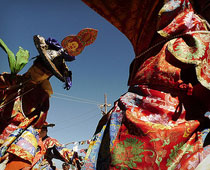 Located in picturesque Zanskar valley, Sani Monastery belongs to the Drugpa Kagyud school of Tibetan Buddhism. It is thought to be the oldest religious site in the whole region of Ladakh and Zanskar. The Gompa was built to accommodate an ancient chorten 6 m (20 ft) high and of unusual shape, known as the Kanika Chorten, is presumed to date back to the time of the famous Kushana emperor, Kanishka (127 CE). The monastery is also claimed to be connected with the famous Indian Yogi Naropa (956-1041 CE). There is now small room next to the Kanika Chorten where it is believed that Naropa meditated in which there is a veiled bronze statue of the yogi. The smaller temple dedicated to Naropa is decorated with unique bas-reliefs in stucco painted in bright colors and with niches for the images. There is also "a magnificent plantation of huge old poplars" adjoining the gompa - a rare treat in the mostly treeless Zanskar. Festivals, Nungnes has no fixed date but usually takes place in July. Sani Naro-Nasjal is usually in the first week of August, between the 15th and the 20th of the sixth Tibetan month.
Located in picturesque Zanskar valley, Sani Monastery belongs to the Drugpa Kagyud school of Tibetan Buddhism. It is thought to be the oldest religious site in the whole region of Ladakh and Zanskar. The Gompa was built to accommodate an ancient chorten 6 m (20 ft) high and of unusual shape, known as the Kanika Chorten, is presumed to date back to the time of the famous Kushana emperor, Kanishka (127 CE). The monastery is also claimed to be connected with the famous Indian Yogi Naropa (956-1041 CE). There is now small room next to the Kanika Chorten where it is believed that Naropa meditated in which there is a veiled bronze statue of the yogi. The smaller temple dedicated to Naropa is decorated with unique bas-reliefs in stucco painted in bright colors and with niches for the images. There is also "a magnificent plantation of huge old poplars" adjoining the gompa - a rare treat in the mostly treeless Zanskar. Festivals, Nungnes has no fixed date but usually takes place in July. Sani Naro-Nasjal is usually in the first week of August, between the 15th and the 20th of the sixth Tibetan month.
BARDAN GOMPA (Zanskar)
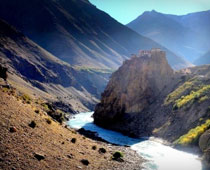 Located in Zanskar valley, Bardan Gompa was founded in 17th century. It belongs to the Drugpa-Kargyud monastic order and was one of the first monasteries of this sect to be established in Zanskar. The monastery also ran several smaller hermitages in the area. The monastery consists of a large Dukhang or assembly hall which has some grand statues of Buddhist figures and several small stupas in clay, bronze, wood and copper.
Located in Zanskar valley, Bardan Gompa was founded in 17th century. It belongs to the Drugpa-Kargyud monastic order and was one of the first monasteries of this sect to be established in Zanskar. The monastery also ran several smaller hermitages in the area. The monastery consists of a large Dukhang or assembly hall which has some grand statues of Buddhist figures and several small stupas in clay, bronze, wood and copper.
KARSHA GOMPA (Zanskar)
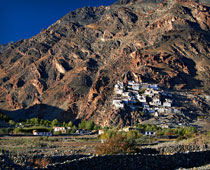 Founded by the Great Translator Phagspa Shesrab of Zanskar , Karsha Gompa is situated on craggy hill, the site of an ancient palace and fort of valley on the bank of Stod River and is the largest and most important monastery of Zanskar valley. The monastery belongs to the Gelugpa sect and is under the jurisdiction of the younger brother of the Dalai Lama Ngari Rinpoche. The Gompa consists of a number of shrines and boasts of some of the most exquisite wall paintings, includes the bone relics of renowned holy Abbot Lama Dorje Rinchen. One of the shrine rooms has 500 year old fascinating wall painting. The oldest remaining shrine room have statue of Avalokiteshvara-Bodhisattva of compassion and beautiful frescos paintings which are believed to be associated with the great Translator Rinchen Zangpo (958-1055). Monastery serves as the residence of approximately 100 monks.
Founded by the Great Translator Phagspa Shesrab of Zanskar , Karsha Gompa is situated on craggy hill, the site of an ancient palace and fort of valley on the bank of Stod River and is the largest and most important monastery of Zanskar valley. The monastery belongs to the Gelugpa sect and is under the jurisdiction of the younger brother of the Dalai Lama Ngari Rinpoche. The Gompa consists of a number of shrines and boasts of some of the most exquisite wall paintings, includes the bone relics of renowned holy Abbot Lama Dorje Rinchen. One of the shrine rooms has 500 year old fascinating wall painting. The oldest remaining shrine room have statue of Avalokiteshvara-Bodhisattva of compassion and beautiful frescos paintings which are believed to be associated with the great Translator Rinchen Zangpo (958-1055). Monastery serves as the residence of approximately 100 monks.


